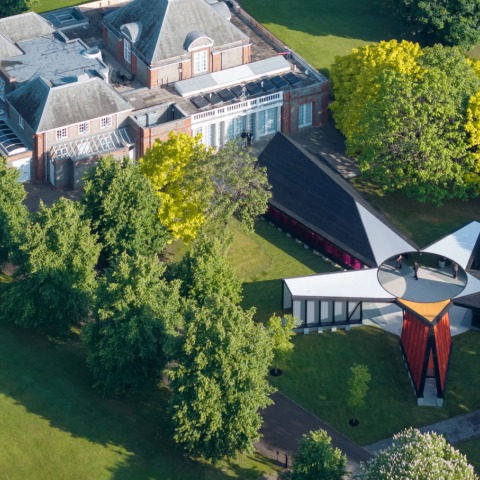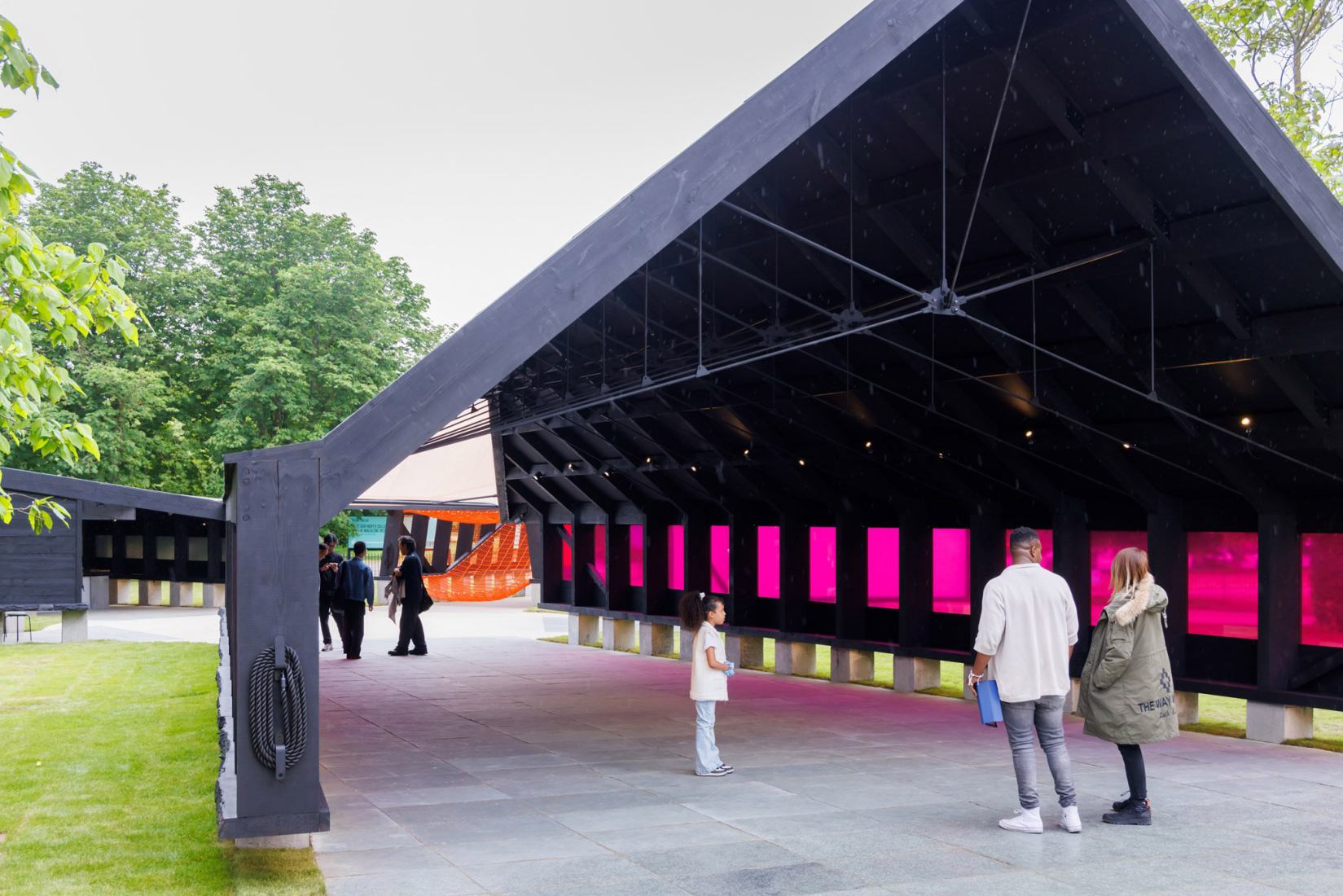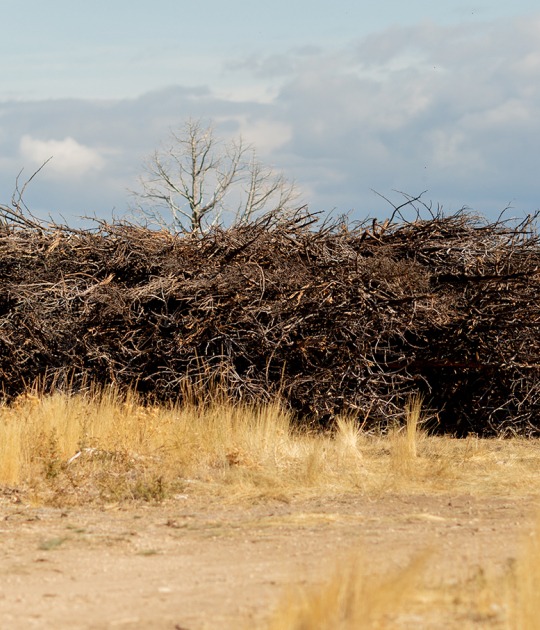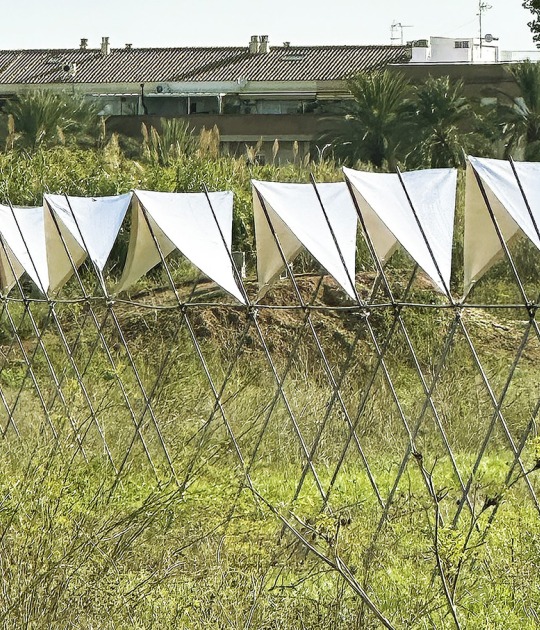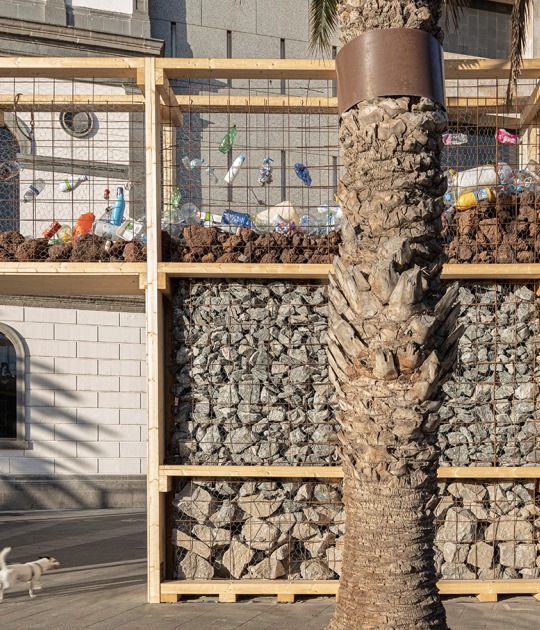Archipelagic Void by Mass Studies is composed of a unique void in the centre surrounded by a series of smaller, adaptable structures located at its periphery. The layout references the madang or an open courtyard found in traditional Korean houses.
Around the void, each structure of this multifaceted Pavilion is envisioned as a "content machine" with a distinct name and purpose, including the Gallery, the Library, the Auditorium, the Tea House and the Play Tower. Assembled, the parts become ten spaces surrounding the void: creating five distinct covered spaces and five open, in-between areas that integrate with the surrounding park and Pavilion activities.
Programme
As the main entrance to the Pavilion, the Gallery plays host to a six-channel sound installation created by musician and composer Jang Young-Gyu, presenting The Willow is버들은 in the Summer and Moonlight 월정명 in the Autumn. Taking inspiration from the surrounding environment of the Pavilion, Jang incorporates sounds from nature and human activities recorded in Kensington Gardens with traditional Korean vocal music and instruments. The distinctive tones and melodies trace the changing of seasons. The piece responds to the constantly transforming landscape of the Park.
Located to the north of the Pavilion is The Library of Unread Books by artist Heman Chong and archivist Renée Staal. Conceived as an artwork that functions as a "living" reference library, each book has been donated by its previous owner to form a pool of common knowledge. Visitors are welcome to contribute and submit an unread book in their possession to the growing collection. By making these titles accessible, The Library of Unread Books functions as a collective gesture, addressing notions of access and distribution.
In a nod to the history of the Serpentine building, the Tea House will be located to the east of the Pavilion. Designed by James Grey West, the Serpentine South building opened in 1934 and originally functioned as a teahouse until the early 1960s, before reopening as an art gallery in 1970.
To the west, is the Auditorium, the largest structure of the five 'islands'. With benches built into its inner walls, the space allows for public gatherings and will feature a programme of performances and talks.
Providing a space for outdoor play, the Pavilion also features the Play Tower, a pyramid structure fitted with a bright orange netscape allowing visitors to climb and interact.
Around the void, each structure of this multifaceted Pavilion is envisioned as a "content machine" with a distinct name and purpose, including the Gallery, the Library, the Auditorium, the Tea House and the Play Tower. Assembled, the parts become ten spaces surrounding the void: creating five distinct covered spaces and five open, in-between areas that integrate with the surrounding park and Pavilion activities.
Programme
As the main entrance to the Pavilion, the Gallery plays host to a six-channel sound installation created by musician and composer Jang Young-Gyu, presenting The Willow is버들은 in the Summer and Moonlight 월정명 in the Autumn. Taking inspiration from the surrounding environment of the Pavilion, Jang incorporates sounds from nature and human activities recorded in Kensington Gardens with traditional Korean vocal music and instruments. The distinctive tones and melodies trace the changing of seasons. The piece responds to the constantly transforming landscape of the Park.
Located to the north of the Pavilion is The Library of Unread Books by artist Heman Chong and archivist Renée Staal. Conceived as an artwork that functions as a "living" reference library, each book has been donated by its previous owner to form a pool of common knowledge. Visitors are welcome to contribute and submit an unread book in their possession to the growing collection. By making these titles accessible, The Library of Unread Books functions as a collective gesture, addressing notions of access and distribution.
In a nod to the history of the Serpentine building, the Tea House will be located to the east of the Pavilion. Designed by James Grey West, the Serpentine South building opened in 1934 and originally functioned as a teahouse until the early 1960s, before reopening as an art gallery in 1970.
To the west, is the Auditorium, the largest structure of the five 'islands'. With benches built into its inner walls, the space allows for public gatherings and will feature a programme of performances and talks.
Providing a space for outdoor play, the Pavilion also features the Play Tower, a pyramid structure fitted with a bright orange netscape allowing visitors to climb and interact.
The Serpentine Pavilion 2024 will also become a platform for Serpentine's Park Nights, the annual interdisciplinary platform for live encounters in music, poetry, performance, and dance that will see artists create brand-new site-specific works. This year's Park Nights will present a dance performance by choreographer Eun-Me Ahn and her company on Friday, 28 June and Saturday, 29 June and an evening of poetry bringing together internationally acclaimed poets Don Mee Choi and Denise Riley and guests on Friday, 19 July. Further details will be announced soon.
In July, Serpentine Arts Technologies will host a day of events exploring the relationship of technology, property, and ecology. Visitors will be invited to become stewards of a collective artwork initiated by Tomás Saraceno and his long-term collaborators, the communities of Salinas Grandes in Jujuy, Argentina. Titled Fairclouds, this unique project builds connections between the cycles of water, information and life. By purchasing a partial common ownership licence and becoming part of an international network of stewards, audiences will support the work of indigenous communities in Argentina. The project is part of an ongoing collaboration between Serpentine Arts Technologies, RadicalxChange and Aerocene Foundation.
In July, Serpentine Arts Technologies will host a day of events exploring the relationship of technology, property, and ecology. Visitors will be invited to become stewards of a collective artwork initiated by Tomás Saraceno and his long-term collaborators, the communities of Salinas Grandes in Jujuy, Argentina. Titled Fairclouds, this unique project builds connections between the cycles of water, information and life. By purchasing a partial common ownership licence and becoming part of an international network of stewards, audiences will support the work of indigenous communities in Argentina. The project is part of an ongoing collaboration between Serpentine Arts Technologies, RadicalxChange and Aerocene Foundation.
